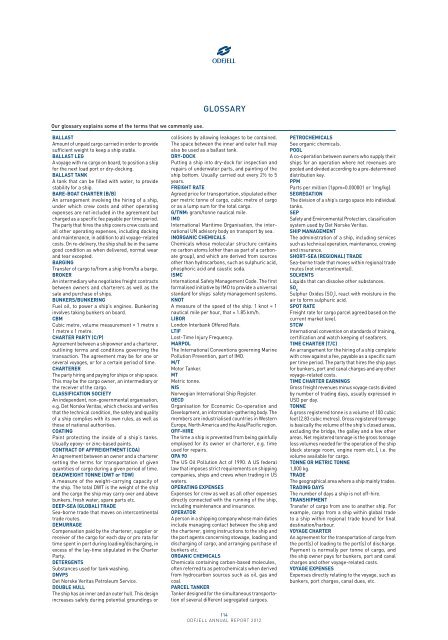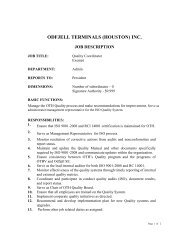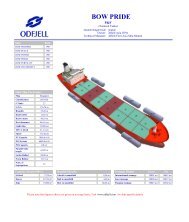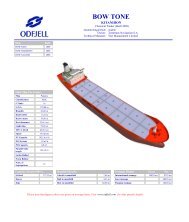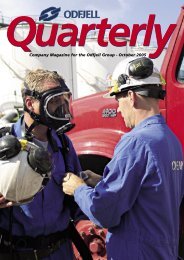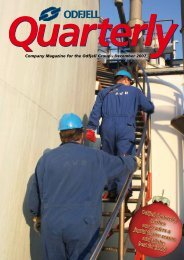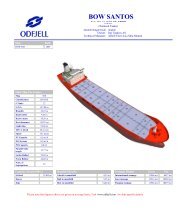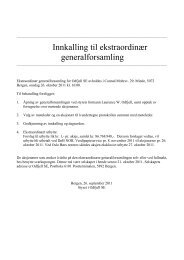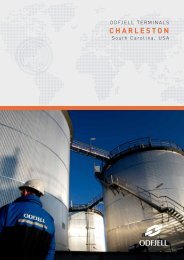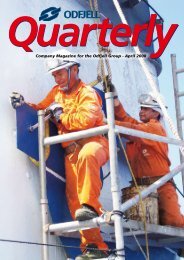Odfjell SE Annual Report 2012
Odfjell SE Annual Report 2012
Odfjell SE Annual Report 2012
You also want an ePaper? Increase the reach of your titles
YUMPU automatically turns print PDFs into web optimized ePapers that Google loves.
Glossary<br />
Our glossary explains some of the terms that we commonly use.<br />
BALLAST<br />
Amount of unpaid cargo carried in order to provide<br />
sufficient weight to keep a ship stable.<br />
BALLAST LEG<br />
A voyage with no cargo on board, to position a ship<br />
for the next load port or dry-docking.<br />
BALLAST TANK<br />
A tank that can be filled with water, to provide<br />
stability for a ship.<br />
BARE-BOAT CHARTER (B/B)<br />
An arrangement involving the hiring of a ship,<br />
under which crew costs and other operating<br />
expenses are not included in the agreement but<br />
charged as a specific fee payable per time period.<br />
The party that hires the ship covers crew costs and<br />
all other operating expenses, including docking<br />
and maintenance, in addition to all voyage-related<br />
costs. On re-delivery, the ship shall be in the same<br />
good condition as when delivered, normal wear<br />
and tear excepted.<br />
BARGING<br />
Transfer of cargo to/from a ship from/to a barge.<br />
BROKER<br />
An intermediary who negotiates freight contracts<br />
between owners and charterers as well as the<br />
sale and purchase of ships.<br />
BUNKERS/BUNKERING<br />
Fuel oil, to power a ship’s engines. Bunkering<br />
involves taking bunkers on board.<br />
CBM<br />
Cubic metre, volume measurement = 1 metre x<br />
1 metre x 1 metre.<br />
CHARTER PARTY (C/P)<br />
Agreement between a shipowner and a charterer,<br />
outlining terms and conditions governing the<br />
transaction. The agreement may be for one or<br />
several voyages, or for a certain period of time.<br />
CHARTERER<br />
The party hiring and paying for ships or ship space.<br />
This may be the cargo owner, an intermediary or<br />
the receiver of the cargo.<br />
CLASSIFICATION SOCIETY<br />
An independent, non-governmental organisation,<br />
e.g. Det Norske Veritas, which checks and verifies<br />
that the technical condition, the safety and quality<br />
of a ship complies with its own rules, as well as<br />
those of national authorities.<br />
COATING<br />
Paint protecting the inside of a ship’s tanks.<br />
Usually epoxy- or zinc-based paints.<br />
CONTRACT OF AFFREIGHTMENT (COA)<br />
An agreement between an owner and a charterer<br />
setting the terms for transportation of given<br />
quantities of cargo during a given period of time.<br />
DEADWEIGHT TONNE (DWT or TDW)<br />
A measure of the weight-carrying capacity of<br />
the ship. The total DWT is the weight of the ship<br />
and the cargo the ship may carry over and above<br />
bunkers, fresh water, spare parts etc.<br />
DEEP-<strong>SE</strong>A (GLOBAL) TRADE<br />
Sea-borne trade that moves on intercontinental<br />
trade routes.<br />
DEMURRAGE<br />
Compensation paid by the charterer, supplier or<br />
receiver of the cargo for each day or pro rata for<br />
time spent in port during loading/discharging, in<br />
excess of the lay-time stipulated in the Charter<br />
Party.<br />
DETERGENTS<br />
Substances used for tank washing.<br />
DNVPS<br />
Det Norske Veritas Petroleum Service.<br />
DOUBLE HULL<br />
The ship has an inner and an outer hull. This design<br />
increases safety during potential groundings or<br />
collisions by allowing leakages to be contained.<br />
The space between the inner and outer hull may<br />
also be used as a ballast tank.<br />
DRY-DOCK<br />
Putting a ship into dry-dock for inspection and<br />
repairs of underwater parts, and painting of the<br />
ship bottom. Usually carried out every 2½ to 5<br />
years.<br />
FREIGHT RATE<br />
Agreed price for transportation, stipulated either<br />
per metric tonne of cargo, cubic metre of cargo<br />
or as a lump sum for the total cargo.<br />
G/TNM: gram/tonne nautical mile.<br />
IMO<br />
International Maritime Organisation, the international<br />
UN advisory body on transport by sea.<br />
INORGANIC CHEMICALS<br />
Chemicals whose molecular structure contains<br />
no carbon atoms (other than as part of a carbonate<br />
group), and which are derived from sources<br />
other than hydrocarbons, such as sulphuric acid,<br />
phosphoric acid and caustic soda.<br />
ISMC<br />
International Safety Management Code. The first<br />
formalised initiative by IMO to provide a universal<br />
standard for ships’ safety management systems.<br />
KNOT<br />
A measure of the speed of the ship. 1 knot = 1<br />
nautical mile per hour, that ≈ 1.85 km/h.<br />
LIBOR<br />
London Interbank Offered Rate.<br />
LTIF<br />
Lost-Time Injury Frequency.<br />
MARPOL<br />
The International Conventions governing Marine<br />
Pollution Prevention, part of IMO.<br />
M/T<br />
Motor Tanker.<br />
MT<br />
Metric tonne.<br />
NIS<br />
Norwegian International Ship Register.<br />
OECD<br />
Organisation for Economic Co-operation and<br />
Development, an information-gathering body. The<br />
members are industrialised countries in Western<br />
Europe, North America and the Asia/Pacific region.<br />
OFF-HIRE<br />
The time a ship is prevented from being gainfully<br />
employed for its owner or charterer, e.g. time<br />
used for repairs.<br />
OPA 90<br />
The US Oil Pollution Act of 1990. A US federal<br />
law that imposes strict requirements on shipping<br />
companies, ships and crews when trading in US<br />
waters.<br />
OPERATING EXPEN<strong>SE</strong>S<br />
Expenses for crew as well as all other expenses<br />
directly connected with the running of the ship,<br />
including maintenance and insurance.<br />
OPERATOR<br />
A person in a shipping company whose main duties<br />
include managing contact between the ship and<br />
the charterer, giving instructions to the ship and<br />
the port agents concerning stowage, loading and<br />
discharging of cargo, and arranging purchase of<br />
bunkers etc.<br />
ORGANIC CHEMICALS<br />
Chemicals containing carbon-based molecules,<br />
often referred to as petrochemicals when derived<br />
from hydrocarbon sources such as oil, gas and<br />
coal.<br />
PARCEL TANKER<br />
Tanker designed for the simultaneous transportation<br />
of several different segregated cargoes.<br />
PETROCHEMICALS<br />
See organic chemicals.<br />
POOL<br />
A co-operation between owners who supply their<br />
ships for an operation where net revenues are<br />
pooled and divided according to a pre-determined<br />
distribution key.<br />
PPM<br />
Parts per million (1ppm=0.000001 or 1mg/kg).<br />
<strong>SE</strong>GREGATION<br />
The division of a ship’s cargo space into individual<br />
tanks.<br />
<strong>SE</strong>P<br />
Safety and Environmental Protection, classification<br />
system used by Det Norske Veritas.<br />
SHIP MANAGEMENT<br />
The administration of a ship, including services<br />
such as technical operation, maintenance, crewing<br />
and insurance.<br />
SHORT-<strong>SE</strong>A (REGIONAL) TRADE<br />
Sea-borne trade that moves within regional trade<br />
routes (not intercontinental).<br />
SOLVENTS<br />
Liquids that can dissolve other substances.<br />
SO x<br />
Sulphur Oxides (SO x<br />
), react with moisture in the<br />
air to form sulphuric acid.<br />
SPOT RATE<br />
Freight rate for cargo parcel agreed based on the<br />
current market level.<br />
STCW<br />
International convention on standards of training,<br />
certification and watch keeping of seafarers.<br />
TIME CHARTER (T/C)<br />
An arrangement for the hiring of a ship complete<br />
with crew against a fee, payable as a specific sum<br />
per time period. The party that hires the ship pays<br />
for bunkers, port and canal charges and any other<br />
voyage-related costs.<br />
TIME CHARTER EARNINGS<br />
Gross freight revenues minus voyage costs divided<br />
by number of trading days, usually expressed in<br />
USD per day.<br />
TONNE<br />
A gross registered tonne is a volume of 100 cubic<br />
feet (2.83 cubic metres). Gross registered tonnage<br />
is basically the volume of the ship’s closed areas,<br />
excluding the bridge, the galley and a few other<br />
areas. Net registered tonnage is the gross tonnage<br />
less volumes needed for the operation of the ship<br />
(deck storage room, engine room etc.), i.e. the<br />
volume available for cargo.<br />
TONNE OR METRIC TONNE<br />
1,000 kg.<br />
TRADE<br />
The geographical area where a ship mainly trades.<br />
TRADING DAYS<br />
The number of days a ship is not off-hire.<br />
TRANSHIPMENT<br />
Transfer of cargo from one to another ship. For<br />
example, cargo from a ship within global trade<br />
to a ship within regional trade bound for final<br />
destination/harbour.<br />
VOYAGE CHARTER<br />
An agreement for the transportation of cargo from<br />
the port(s) of loading to the port(s) of discharge.<br />
Payment is normally per tonne of cargo, and<br />
the ship owner pays for bunkers, port and canal<br />
charges and other voyage-related costs.<br />
VOYAGE EXPEN<strong>SE</strong>S<br />
Expenses directly relating to the voyage, such as<br />
bunkers, port charges, canal dues, etc.<br />
114<br />
odfjell annual report <strong>2012</strong>


